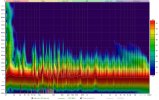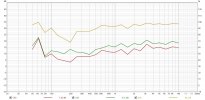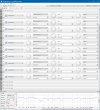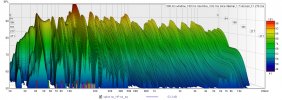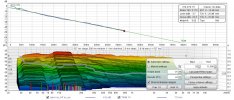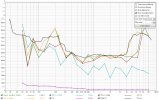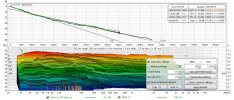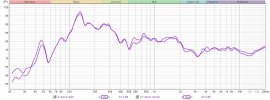So I measured my speakers (Kali IN-8 V2) in room, with UMIK-1 located roughly in the middle of my head position, and with it orientated vertically and with 90° cal file applied. In REW I then applied a HPF to Harman room curve and EQ'd to that line, and the resulting measurement got much better;
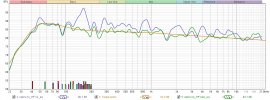
I then listened to it like this for a couple of hours. Initially it seemed good because there are no super-obvious loud spots in the response (and I hadn't listened to much music for a few days), but after a while I had the feeling it wasn't so great. When I came back the next day to listen to it with fresh ears, it immediately sounded off. Using EQ APO I toggled the EQ on and off, and with the EQ on it sounded/felt like a void in the music that was actually "sucking in" the music. Not all of the spectrum, but definitely in the important midrange. It is very strange. I wondered if it is phase issue, but nothing major looks different in it. I now wonder if it is simply too much EQ (dropped the levels too much)? But if I'm EQ'ing to the room curve, how could this be?
So the next thing I did is leave that EQ off, but I copied over and applied the 50Hz -4.3dB PEQ, and the 160Hz PEQ except I reduced it from -13dB to -10dB. I listened like this for a little while, and whilst there were some "loud spots" that still needed taming, the "void" was gone. I then copied the 288 Hz PEQ but also reduced it from -6.8Db to -3.8dB. I have listened it this way for a few hours now, and it sounds "better" - it being "less" EQ (not so strict to the room curve). I am now wondering why this is the case? More so, what is the real reason behind my experience?
I have some thoughts on this already. But my thoughts are impacted by an experience I once had and that is related to my ears, as my ears stick out a little (are more forward facing the usual). Many years ago I had a pair of cheapish Beyerdynamic open headphones, the DT440's. I really liked the sound of these (for what they were to me at the time), and so when they needed replacing I opted for the apparently better quality and closed model DT770's, because I was going to be using them on the train a lot. But I hated the sound of the 770's. Something was off about them, and it was like the headphone was inside a sea-shell strapped to my head. It was a very peculiar experience considering their reputation on the internet. In testing I realised that if I pinched the tip of my ear beneath the pad, thus flattening my ear, they sounded better. So I came to the conclusion that the geometry of my ears is affecting either the sound output of the headphone driver, or it's to do with the way my ears receive the sound. I gave away the 770's (the recipient liked them) and got some 880's, and they sounded good and proper, like I expected compared to the 440's.
So I'm wondering if my ears are impacting what I am hearing in my room in an unusual manor? Perhaps my hearing is more sensitive to sounds coming from in front of me, rather than reflections from behind me? The mic however is picking up all sounds, and I presume REW is treating them all "equally" (to suit a normal listener). But if I'm more sensitive to forward sounds, then this might be why I'm apparently over EQ'ing and creating a "void"? So now I wonder if I need to somewhat time-gate the reflections in REW, or if I can reduce the way late reflections are added in to the mix vs early reflections and direct sound? And then I wonder if perhaps I am more sensitive to forward sounds in the higher or mid frequencies vs the lower, and so any adjustments to REW measurements need to be on a slope?
Another thought I had was that maybe I just need to measure at various points around my heads position, and then average them, and EQ against that average? I've seen a few mentions of this method on the forum but haven't look in to it thoroughly, but perhaps it is more proper?
What do you think?

I then listened to it like this for a couple of hours. Initially it seemed good because there are no super-obvious loud spots in the response (and I hadn't listened to much music for a few days), but after a while I had the feeling it wasn't so great. When I came back the next day to listen to it with fresh ears, it immediately sounded off. Using EQ APO I toggled the EQ on and off, and with the EQ on it sounded/felt like a void in the music that was actually "sucking in" the music. Not all of the spectrum, but definitely in the important midrange. It is very strange. I wondered if it is phase issue, but nothing major looks different in it. I now wonder if it is simply too much EQ (dropped the levels too much)? But if I'm EQ'ing to the room curve, how could this be?
So the next thing I did is leave that EQ off, but I copied over and applied the 50Hz -4.3dB PEQ, and the 160Hz PEQ except I reduced it from -13dB to -10dB. I listened like this for a little while, and whilst there were some "loud spots" that still needed taming, the "void" was gone. I then copied the 288 Hz PEQ but also reduced it from -6.8Db to -3.8dB. I have listened it this way for a few hours now, and it sounds "better" - it being "less" EQ (not so strict to the room curve). I am now wondering why this is the case? More so, what is the real reason behind my experience?
I have some thoughts on this already. But my thoughts are impacted by an experience I once had and that is related to my ears, as my ears stick out a little (are more forward facing the usual). Many years ago I had a pair of cheapish Beyerdynamic open headphones, the DT440's. I really liked the sound of these (for what they were to me at the time), and so when they needed replacing I opted for the apparently better quality and closed model DT770's, because I was going to be using them on the train a lot. But I hated the sound of the 770's. Something was off about them, and it was like the headphone was inside a sea-shell strapped to my head. It was a very peculiar experience considering their reputation on the internet. In testing I realised that if I pinched the tip of my ear beneath the pad, thus flattening my ear, they sounded better. So I came to the conclusion that the geometry of my ears is affecting either the sound output of the headphone driver, or it's to do with the way my ears receive the sound. I gave away the 770's (the recipient liked them) and got some 880's, and they sounded good and proper, like I expected compared to the 440's.
So I'm wondering if my ears are impacting what I am hearing in my room in an unusual manor? Perhaps my hearing is more sensitive to sounds coming from in front of me, rather than reflections from behind me? The mic however is picking up all sounds, and I presume REW is treating them all "equally" (to suit a normal listener). But if I'm more sensitive to forward sounds, then this might be why I'm apparently over EQ'ing and creating a "void"? So now I wonder if I need to somewhat time-gate the reflections in REW, or if I can reduce the way late reflections are added in to the mix vs early reflections and direct sound? And then I wonder if perhaps I am more sensitive to forward sounds in the higher or mid frequencies vs the lower, and so any adjustments to REW measurements need to be on a slope?
Another thought I had was that maybe I just need to measure at various points around my heads position, and then average them, and EQ against that average? I've seen a few mentions of this method on the forum but haven't look in to it thoroughly, but perhaps it is more proper?
What do you think?


